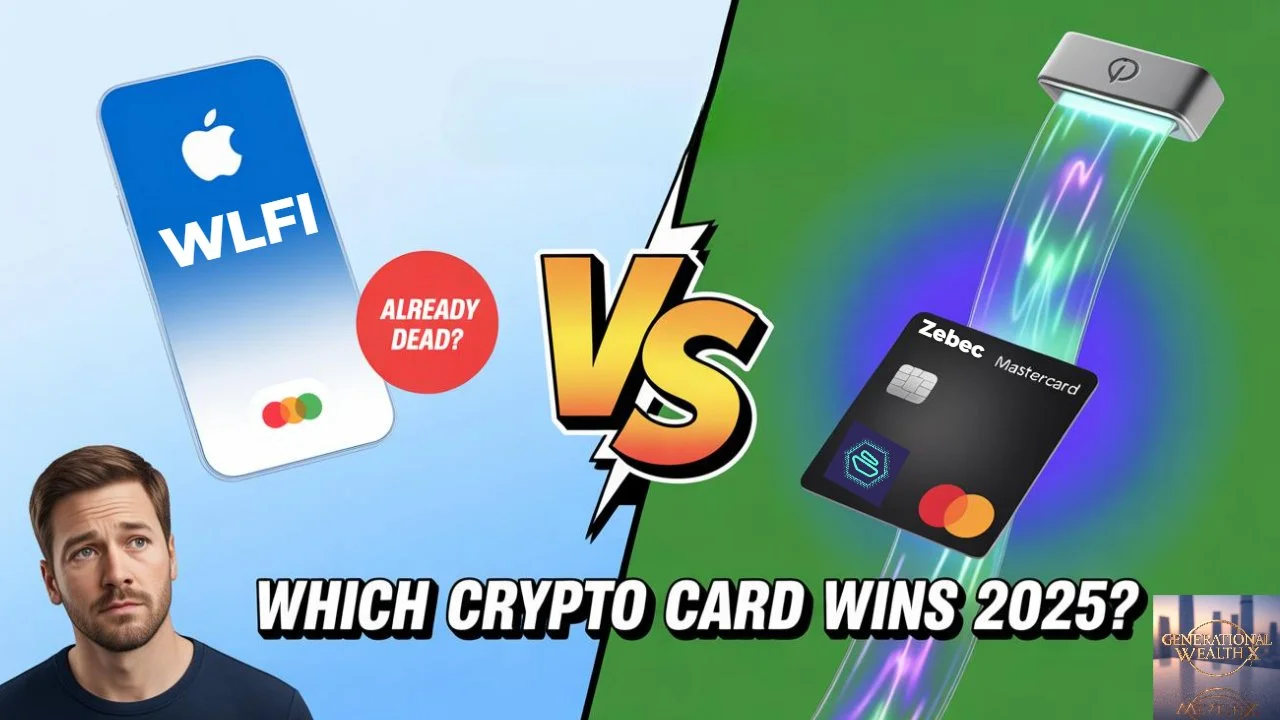Is Solana The Next Ethereum? Let's Break It Down
For years, Ethereum has worn the crown, but we've all felt the pain of its crippling gas fees. Now, a rival has emerged, built for insane speed and near-zero cost. Can this challenger, Solana, actually dethrone the giant, or is it just a pretender?
Is the crypto world big enough for two kings?
For years, Ethereum has worn the crown, but we've all felt the pain of its crippling gas fees. Now, a rival has emerged, built for insane speed and near-zero cost. Can this challenger, Solana, actually dethrone the giant, or is it just a pretender?
By the end of this article, you'll know exactly where the smart money might be headed.
The Ethereum Problem: Speed Bumps on the Highway
For all its strengths, using Ethereum can feel slow and expensive. As the original smart contract platform, it has earned tremendous trust and built a massive community of developers. But its own popularity has created serious traffic jams.
The numbers tell the story:
At its core, the Ethereum base layer can only handle about 15 to 30 transactions per second. When the network gets busy—think popular NFT mints or DeFi rushes—it turns into a bidding war to get transactions through.
Those fees, known as gas, can skyrocket. While recent upgrades and Layer-2 solutions have helped, fees remain unpredictable and can jump to several dollars during peak times, making small transactions totally impractical.
That frustration created the perfect opening for a new kind of blockchain.
Enter Solana: Built Different from Day One
Launched in 2020, Solana brought a revolutionary concept to the table: Proof-of-History. This innovation timestamps transactions before they're processed, allowing the network to handle massive amounts of activity simultaneously.
The Performance Gap is Staggering
Where Ethereum's speed is measured in seconds, Solana's is measured in milliseconds. The network handles a real-world average of about 870 transactions per second, with observed peaks exceeding 4,700 TPS.
And the cost? An average Solana transaction costs just a tiny fraction of a cent.
This combination of incredible speed and ultra-low costs has made Solana the go-to platform for applications that need to be fast and affordable:
High-frequency trading platforms
Social media applications
Blockchain gaming
Micro-payment systems
Head-to-Head: The Ultimate Blockchain Showdown
Let's break down how these two titans really compare across the metrics that matter.
Speed and Scalability: Solana Dominates
On the base layer, it's not even a contest. Solana's thousands of potential transactions per second blow Ethereum's 15-30 out of the water.
Yes, Ethereum's Layer-2 solutions can deliver faster speeds, but they add extra steps and can make the user experience feel disconnected. Solana delivers its performance right on the main chain—no compromises.
Cost Efficiency: Another Win for Solana
Solana maintains a huge advantage here. Its fees are tiny and predictable, perfect for micro-payments or high-frequency transactions. Ethereum's fees, while improving, remain a significant barrier for many users and applications.
Ecosystem and Adoption: The Plot Thickens
This is where things get interesting.
Ethereum still leads with:
The largest developer community (thousands of monthly active developers)
The most capital locked in DeFi protocols
The most established infrastructure and tooling
But Solana is catching up at breakneck speed:
Daily active users: 1.5-2.5 million (Solana) vs. 400,000-600,000 (Ethereum)
Rapidly growing DeFi ecosystem
Increasing institutional adoption
Decentralization and Security: Ethereum's Stronghold
This is where Ethereum truly shines. The network is secured by over one million staking validators (though the number of unique node operators is much lower, in the thousands), making it incredibly decentralized and resilient against attacks.
Solana operates with approximately 3,200 validators. However, running a Solana validator requires powerful, expensive hardware, which has sparked ongoing debates about centralization concerns.
The Honest Truth: Acknowledging the Downsides
No platform is perfect, and we need to be real about the drawbacks.
Solana's Achilles Heel: Network Stability
Solana's biggest weakness has been network reliability. The platform has experienced several high-profile outages that damaged its reputation. While uptime has improved significantly in 2025, claiming 100% reliability isn't accurate—minor incidents and slowdowns still occur.
Ethereum's Challenge: Evolution Speed
Ethereum's main criticism centers on its slow core technology evolution and reliance on a complex web of Layer-2 solutions to solve scaling problems. While these solutions work, they can confuse newcomers, and moving assets between layers can be slow and costly.
The critical question: Can the main network evolve quickly enough to maintain its competitive edge?
The Verdict: Who Actually Wins?
Here's the truth: asking "Is Solana the next Ethereum?" might be the wrong question entirely.
These blockchains appear built for fundamentally different purposes:
Ethereum is playing the long game, prioritizing security and decentralization to become the global settlement layer for high-value assets—the platform where ultimate trust matters most.
Solana is all about speed and scale, positioning itself as the engine for a new generation of applications that need to feel as fast and affordable as the web apps we use daily.
The Multi-Chain Future
Instead of one winner taking all, the future likely features multiple thriving chains. Ethereum and Solana might not be direct rivals, but complementary pillars of a decentralized internet:
Ethereum: The trusted, secure foundation for high-value transactions
Solana: The high-performance layer for daily activity and mass adoption
What's Your Take?
Which blockchain are you betting on for the future? Are you team Ethereum, team Solana, or team "both have their place"?
Join the conversation by leaving your thoughts in the comments below, and don't forget to join our insiders group at
GenerationalWealth.biz for exclusive crypto insights.
Is WLFI's Crypto Card Already Obsolete Before Launch?
What if a company invested millions developing a revolutionary product, only to discover it was outdated on day one?
World Liberty Financial (WLFI) is making waves with its upcoming crypto debit card. But in the rapidly evolving cryptocurrency landscape, the technology powering your solution can determine your success or failure. While WLFI promises to bridge crypto and everyday spending with its dollar-pegged stablecoin and Apple Pay integration, another network is building an entirely different foundation for the future of digital payments.
Let's examine two competing visions for crypto payment cards—one focused on user experience, the other on revolutionary architecture—and determine which approach is truly built for longevity.
WLFI's Strategy: User Experience First
World Liberty Financial has announced a debit card for their one-dollar stablecoin, featuring seamless Apple Pay integration for effortless spending. They're developing an application described as "Venmo meets Robinhood," designed to merge simple peer-to-peer payments with cryptocurrency trading capabilities.
The Surface-Level Appeal
This approach makes strategic sense. By making crypto feel familiar and accessible, WLFI lowers the barrier to entry for mainstream adoption. However, the critical question isn't about the interface—it's about how money moves behind the scenes.
The Infrastructure Reality
WLFI has explicitly stated they will not build their own blockchain, opting instead for a "chain-agnostic" approach. This means operating on established networks like Ethereum and Solana.
The advantages:
Focus resources on user experience rather than infrastructure development
Create a bridge between decentralized finance (DeFi) and traditional commerce
Avoid the complexity of blockchain maintenance
The limitations:
Transaction speed depends entirely on host networks
Cost efficiency is constrained by underlying blockchain fees
Settlement capabilities are limited by third-party infrastructure
Technical details on achieving true decentralization remain unclear
Timeline: Pilot program launches late 2025, with full rollout planned for Q1 2026.
Zebec Network: Infrastructure-First Revolution
Zebec Network represents a fundamentally different philosophy. Rather than building another application layer, Zebec has created a payment infrastructure protocol designed specifically for next-generation finance.
Real-Time Money Streaming Explained
The core innovation is continuous value flow. Traditional finance processes payments in batches—your biweekly paycheck is a perfect example. Zebec enables second-by-second money streaming, allowing your salary to flow into your account continuously as you work.
Real-World Implementation
Zebec has already launched crypto debit cards in partnership with Mastercard. Unlike solutions that simply connect to existing systems, Zebec's entire architecture is purpose-built for instant, continuous settlement.
Head-to-Head Comparison
Transaction Speed ⚡
WLFI: Offers crypto spending through familiar interfaces, but speed is constrained by host blockchain capabilities.
Zebec: Built originally on Solana for maximum throughput, enabling genuine real-time, per-second payments that eliminate traditional settlement delays.
Cost Efficiency 💰
WLFI: Fee structure depends on underlying blockchain networks and intermediary costs.
Zebec: Streamlined on-chain protocol designed for efficiency. Their Zebec Carbon card launched as a zero-fee card.
Functionality & Innovation 🚀
WLFI: Focuses on exceptional user experience for spending and trading within familiar paradigms.
Zebec: Enables "programmable money"—complex, automated payment flows that unlock next-generation financial applications far beyond simple transactions.
Proof of Concept: Real-World Validation
Zebec isn't just theoretical innovation—they're proving their model with substantial partnerships.
The Asure Partnership
Zebec has established a joint venture with Asure, a major Human Capital Management software provider that processes over $10 billion in annual payroll for millions of U.S. employees. This partnership aims to stream payments to thousands of employees, integrating directly into the traditional economy and upgrading it from within.
Why This Matters
When a NASDAQ-listed company like Asure validates your technology, it demonstrates your infrastructure is ready for mainstream adoption. For end users, this means getting paid by the second and instantly spending that money anywhere Mastercard is accepted—a fundamental shift from current financial systems.
The Verdict: Obsolete or Just Different?
Is WLFI's crypto card obsolete before launch? "Obsolete" may be too harsh. The familiar app experience and Apple Pay integration will definitely attract users seeking a simple on-ramp to crypto spending.
However, WLFI's model faces significant challenges from more technologically advanced solutions. The future of payments isn't merely about making crypto spending easier—it's about fundamentally transforming how value moves.
Two Distinct Visions
WLFI is building a user-friendly bridge to existing systems—evolutionary improvement.
Zebec is constructing an entirely new highway—revolutionary transformation.
Networks like Zebec are pioneering real-time, continuous-flow payments that could redefine financial infrastructure. While both approaches have merit, the question becomes: which foundation will support the next decade of financial innovation?
Your Perspective Matters
What do you believe is more critical for mass adoption?
A seamless, "Venmo-like" experience that makes crypto accessible today?
Advanced payment infrastructure that enables entirely new financial possibilities?
Join the conversation by subscribing to our newsletter at
for deeper analysis of the technologies shaping tomorrow's financial landscape.
Disclaimer: This content is for educational purposes only and does not constitute financial advice. I am not a licensed financial advisor. Cryptocurrency investments are highly volatile—never invest more than you can afford to lose. Always conduct thorough research before making investment decisions.



